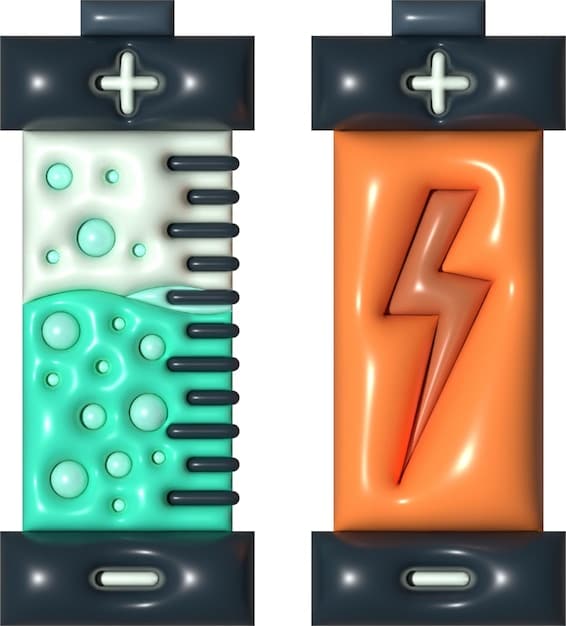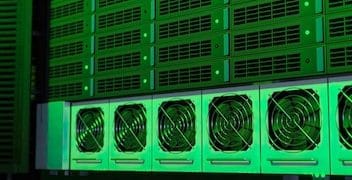Energy Storage System Fire Safety: Mitigating Thermal Runaway Risks in US

Energy storage system (ESS) fire safety in the US demands a comprehensive approach, primarily focused on mitigating thermal runaway, a critical hazard that can lead to catastrophic battery failures and fires, necessitating robust prevention and response strategies.
The burgeoning adoption of energy storage systems (ESS) across the United States, driven by renewable energy integration and grid modernization, has brought energy storage system fire safety: understanding and mitigating thermal runaway risks in US installations into sharp focus.
Understanding the Risks: Thermal Runaway in ESS
Understanding the risks associated with thermal runaway is crucial for ensuring the safe operation of energy storage systems. Thermal runaway, a primary concern in ESS, can result in fires and explosions. It is therefore essential to address the causes and potential consequences to implement effective mitigation strategies.
What is Thermal Runaway?
Thermal runaway is a chain reaction within a battery cell that causes an uncontrolled increase in temperature. This can lead to the release of flammable gases, fire, and potentially even explosions.
Causes of Thermal Runaway
Several factors can trigger thermal runaway in ESS, including:
- Manufacturing Defects: Imperfections in battery cell construction can create weak points susceptible to thermal issues.
- Physical Damage: External impacts or damage to the battery can compromise its structural integrity and lead to thermal runaway.
- Overcharging/Discharging: Operating batteries outside of their specified voltage and current limits can generate excessive heat.
- External Heat Sources: Exposure to high ambient temperatures or nearby heat sources can initiate or accelerate thermal runaway.

Thermal runaway is a complex phenomenon, understanding its causes is only the first step. The implementation of robust preventative measures and appropriate safety protocols are vital to minimize its risk.
Current US Regulations and Standards
Navigating the regulatory landscape for ESS fire safety in the US involves understanding various codes, standards, and local regulations. Compliance is essential for ensuring safety and avoiding potential liabilities. Here’s an overview of the key regulatory aspects in the United States:
National Fire Protection Association (NFPA) Standards
The NFPA is a leading organization in developing and publishing fire safety standards. Key NFPA standards relevant to ESS include:
- NFPA 855: Standard for the Installation of Stationary Energy Storage Systems, providing comprehensive requirements for ESS installation, including fire protection, ventilation, and safety systems.
- NFPA 70: National Electrical Code (NEC), outlining electrical safety requirements for ESS installations.
International Code Council (ICC)
The ICC develops model building codes used by many jurisdictions in the US. The International Fire Code (IFC) includes provisions for ESS fire safety, referencing NFPA 855.
Local and State Regulations
In addition to national standards, many states and local jurisdictions have their own regulations and permitting requirements for ESS installations:
- California: Has specific regulations regarding ESS safety, including requirements for fire protection and emergency response plans.
- New York: Implementing measures to enhance ESS safety, particularly in urban environments.

The adoption and enforcement of ESS fire safety codes and standards in the US are constantly evolving. Regularly updating the knowledge and practice according to the latest guidelines is essential to guarantee the safety and reliability of deployments.
Best Practices for ESS Fire Prevention
Implementing best practices for fire prevention is critical in minimizing the risk of thermal runaway and subsequent fires in energy storage systems. By integrating these practices into ESS design, installation, and operation can dramatically reduce the probabilities of incidents. Effective fire prevention requires a multi-layered approach, focusing on early detection, robust safety mechanisms, and strict adherence to standards.
Battery Management Systems (BMS)
A robust BMS is essential for monitoring and controlling battery performance. The BMS should provide real-time monitoring of cell voltage, temperature, and current. It should also have safety features, such as:
- Overcharge Protection: Preventing batteries from being charged beyond their maximum voltage.
- Over-Discharge Protection: Preventing batteries from being discharged below their minimum voltage.
- Temperature Monitoring: Shutting down the system if temperatures exceed safe limits.
Cell-Level Monitoring
Advanced monitoring technologies provide detailed insights into individual cell performance, enabling early detection of anomalies:
- Voltage and Temperature Sensors: Monitoring each cell for deviations from normal parameters.
- Impedance Monitoring: Detecting changes in cell impedance, which can indicate degradation or potential failure.
Ventilation and Cooling Systems
Effective ventilation and cooling are essential for maintaining optimal operating temperatures:
- HVAC Systems: Regulating air temperature and humidity within the ESS enclosure.
- Liquid Cooling: Using liquid coolants to dissipate heat from battery modules.
By investing strategically in preventive measures like BMS, proactive monitoring, and effective management of ESS, risks can be significantly reduced.
Fire Suppression Technologies for ESS
In the event of thermal runaway, effective fire suppression systems are essential for containing the fire and preventing its spread. Various technologies are available, each with its advantages and disadvantages. Here’s an overview of the primary fire suppression solutions for ESS:
Water-Based Systems
Water-based systems are a common choice due to their cost-effectiveness and availability:
- Sprinkler Systems: Automatically discharge water onto the fire, cooling the batteries and suppressing flames.
- Water Mist Systems: Creating a fine mist that cools the fire and reduces oxygen levels.
Gas-Based Systems
Gas-based systems use inert gases to displace oxygen and extinguish the fire:
- Inert Gas Systems (e.g., Nitrogen, Argon): Reducing oxygen concentration to a level that cannot sustain combustion.
- Chemical Agent Systems (e.g., FM-200, Novec 1230): Interrupting the chemical reaction of the fire to extinguish it rapidly.
Advanced Suppression Technologies
Emerging technologies offer enhanced fire suppression capabilities:
- Aerosol Suppression Systems: Dispersing fine particles of a chemical agent to suppress the fire.
- Lithium-Ion Battery Fire Extinguishers: Specialized extinguishers designed to cool and suppress lithium-ion battery fires.
Selecting the appropriate fire suppression technology depends on many reasons. However, the primary one should be the efficiency of the system, since this ensures the integrity of the ESS systems and reduces the overall risk.
Emergency Response Planning and Training
Effective emergency response planning and training are critical for ensuring the safety of personnel and the successful containment of ESS fires. A well-prepared response can mitigate the damage and protect responders and the surrounding environment. These plans must be comprehensive and inclusive, addressing all possible scenarios.
Developing an Emergency Response Plan
An ERP should include:
- Identification of Hazards: Assessing potential fire hazards and identifying specific risks associated with the ESS installation.
- Emergency Contact List: Maintaining an updated list of emergency contacts, including fire department, medical services, and facility personnel.
- Evacuation Procedures: Establishing clear evacuation routes and procedures for personnel in the event of a fire.
Training Programs
Comprehensive training programs are essential for preparing personnel to respond effectively in emergency situations:
- Fire Safety Training: Educating personnel on fire prevention, detection, and suppression techniques.
- Emergency Response Drills: Conducting regular drills to simulate emergency scenarios and evaluate the effectiveness of response procedures.
Coordination with Local Authorities
Collaborating with local fire departments and emergency services is crucial for effective response:
- Site Visits: Inviting local fire departments to visit the ESS site to familiarize themselves with the layout, hazards, and emergency response procedures.
- Joint Training Exercises: Participating in joint training exercises to coordinate response efforts between facility personnel and local authorities.
By investing in well-designed ERPs, regular training, and strong relations with local authorities, an organization can significantly improve the chances of controlling risks, lowering the impact, and ensuring the safety of everyone involved in an ESS emergency.
Future Trends and Innovations
The field of ESS fire safety is continually evolving, driven by technological advancements and the increasing deployment of energy storage systems. Several future trends and innovations promise to enhance the safety and reliability of ESS installations in the US. Incorporating these advancements can lead to enhanced safety measures and optimized performance.
Advanced Battery Chemistries
Research and development are focused on developing safer battery chemistries:
- Solid-State Batteries: Replacing the liquid electrolyte with a solid electrolyte, reducing the risk of thermal runaway.
- Lithium-Sulfur Batteries: Offering higher energy density and improved safety compared to traditional lithium-ion batteries.
Enhanced Monitoring and Detection Technologies
New sensors and monitoring systems are being developed to provide earlier and more accurate detection of thermal runaway:
- Fiber Optic Sensors: Embedded within battery cells to monitor temperature and strain in real-time.
- Gas Sensors: Detecting the release of gases associated with thermal runaway events.
Artificial Intelligence (AI) and Machine Learning (ML)
AI and ML are being used to analyze ESS data and predict potential failures:
- Predictive Analytics: Using machine learning algorithms to identify patterns and predict thermal runaway events before they occur.
- Automated Response Systems: Automatically activating fire suppression systems based on AI-driven risk assessments.
By staying abreast of these advancements and integrating them into ESS strategies and practices, stakeholders can pave the way for safer, more robust, and reliable energy storage solutions that support the expansion of sustainable energy.
| Key Aspect | Brief Description |
|---|---|
| 🔥 Thermal Runaway | Uncontrolled heat increase in battery cells, leading to fires. |
| 🛡️ Prevention | Utilize BMS, cell monitoring, and proper ventilation systems. |
| 🚒 Suppression | Implement water, gas, and advanced suppression technologies. |
| 💡 Future Trends | Advanced chemistries, AI monitoring to enhance ESS safety. |
Frequently Asked Questions (FAQ)
▼
Thermal runaway is a process where a battery cell’s temperature increases uncontrollably, leading to fire or explosion. This can be triggered by factors like overcharging, physical damage, or manufacturing defects.
▼
Best practices include using a robust Battery Management System (BMS), monitoring cell-level performance, ensuring proper ventilation and cooling, and adhering to regulatory standards like NFPA 855.
▼
Recommended technologies range from water-based sprinkler systems and water mist systems to gas-based and advanced aerosol suppression systems, ensuring efficient cooling and fire extinguishing.
▼
Emergency response planning ensures that personnel are prepared to handle fire incidents efficiently, mitigating damage and protecting responders by coordinating procedures, training, and local support.
▼
Future advancements include safer battery chemistries (e.g., solid-state), enhanced monitoring with fiber optic sensors, and the use of AI for predictive analytics and automated response.
Conclusion
As energy storage systems continue to proliferate, prioritizing fire safety is paramount. By adhering to regulations, implementing best practices, investing in advanced technologies, staying abreast of evolving safety standards, and fostering collaboration among stakeholders, the US can ensure the safe and reliable deployment of ESS, thereby maximizing their benefits for the energy landscape.





